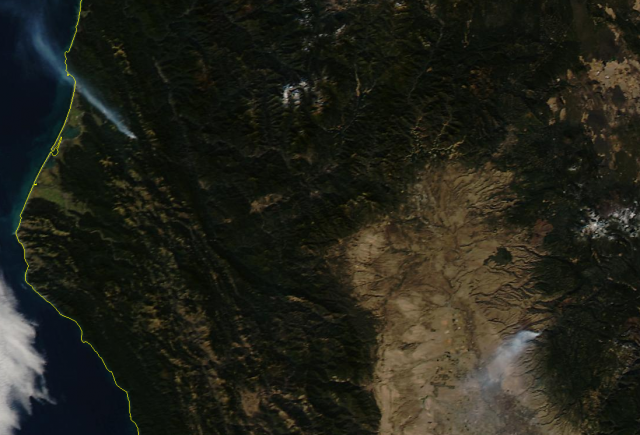
Update, Thursday (Jan. 9): Status of the two Northern California wildfires:
Campbell Fire: The blaze burning in the Ishi Wilderness in Lassen National Forest has covered 865 acres and is 90 percent contained. No injuries or property damage have been reported.
Red Fire: Cal Fire says the 333-acre fire, burning about 15 miles east of the Humboldt County city of Arcata, is 100 percent contained. No injuries or property damage reported.
Original post: It's January, when California firefighters normally get a break from fighting blazes in the state's backlands. But not this year, as the state deals with the consequences of this season's missing rains. As the San Francisco Chronicle reports, and as you can plainly see in NASA satellite images, fires are burning in areas of the North State (and in southern Oregon, too) that are generally too wet to burn at this time of year.
Here's the Chron's Kevin Fagan on the Bay Area impact of fires that have broken out since New Year's Day in Humboldt County and Tehama County:
The Marin County Fire Department rolled its resources north over the weekend to fight the Red Fire about 20 miles east of Arcata in Humboldt County, and to the Campbell Fire about 20 miles east of Red Bluff in the Lassen National Forest.
The two fires have burned a combined 1,000 acres of forest in the past two days. No structures have been threatened or injuries reported, and both blazes are about 40 percent contained.
The fires are a lot less dangerous than many that erupt in the summer. But fire experts are worried all the same, because January is a time of year when the northern reaches of the state normally are too wet to ignite.
"It's unprecedented for us to do this in January," said Battalion Chief Mike Giannini, whose Marin County Fire Department is one of the first to be called upon to send aid north.
"We've sent crews this early in the year in the past to Southern California, because their fire season never seems to end," Giannini said. "But not up there. Not to places like Humboldt, which has coastal, high-humidity, forested types of conditions we would normally equate with low fire danger."
Northern California, like the rest of the state, is far short of its normal rainfall for the season that started last July 1. Eureka, on the Humboldt Coast, has gotten just 28 percent of its seasonal average to date. Redding, at the northern end of the Sacramento Valley, has received 23 percent of normal for early January.